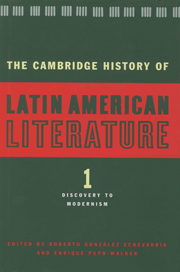Book contents
- Frontmatter
- Introduction to Volume 1
- 1 A brief history of the history of Spanish American Literature
- 2 Cultures in contact: Mesoamerica, the Andes, and the European written tradition
- 3 The first fifty years of Hispanic New World historiography: the Caribbean, Mexico, and Central America
- 4 Historians of the conquest and colonization of the New World: 1550–1620
- 5 Historians of the colonial period: 1620–1700
- 6 Colonial lyric
- 7 Epic poetry
- 8 Spanish American theatre of the colonial period
- 9 Viceregal culture
- 10 The eighteenth century: narrative forms, scholarship, and learning
- 11 Lyric poetry of the eighteenth and nineteenth centuries
- 12 Spanish American theatre of the eighteenth century
- 13 The nineteenth-century Spanish American novel
- 14 The brief narrative in Spanish America: 1835–1915
- 15 The Spanish American theatre of the nineteenth century
- 16 The essay in Spanish South America: 1800 to Modernismo
- 17 The essay of nineteenth-century Mexico, Central America, and the Caribbean
- 18 The gaucho genre
- Index
- Bibliographies
- References
9 - Viceregal culture
Published online by Cambridge University Press: 28 March 2008
- Frontmatter
- Introduction to Volume 1
- 1 A brief history of the history of Spanish American Literature
- 2 Cultures in contact: Mesoamerica, the Andes, and the European written tradition
- 3 The first fifty years of Hispanic New World historiography: the Caribbean, Mexico, and Central America
- 4 Historians of the conquest and colonization of the New World: 1550–1620
- 5 Historians of the colonial period: 1620–1700
- 6 Colonial lyric
- 7 Epic poetry
- 8 Spanish American theatre of the colonial period
- 9 Viceregal culture
- 10 The eighteenth century: narrative forms, scholarship, and learning
- 11 Lyric poetry of the eighteenth and nineteenth centuries
- 12 Spanish American theatre of the eighteenth century
- 13 The nineteenth-century Spanish American novel
- 14 The brief narrative in Spanish America: 1835–1915
- 15 The Spanish American theatre of the nineteenth century
- 16 The essay in Spanish South America: 1800 to Modernismo
- 17 The essay of nineteenth-century Mexico, Central America, and the Caribbean
- 18 The gaucho genre
- Index
- Bibliographies
- References
Summary
The greatest challenge to the concept of a universe in which humankind was central to the explanation of history took place during the sixteenth century. The nature of the relations between peoples across the world took a new turn as European states embarked on unprecedented commercial and colonizing ventures in areas of the world inhabited by people of different races, beliefs, and social organizations. Those undertakings entailed a cultural exchange of political, social, and religious values through a process that was never peaceful, and that implied either the imposition of values by one dominant society on the other, or the displacement of the weaker group. While Europeans found a powerful cultural resistance in India and China, and were unable successfully to establish their culture there, the indigenous societies of the Americas became vulnerable after their military defeat. Spain, the main beneficiary of the first allocation of the newly discovered hemisphere to its west, through the Treaty of Tordesillas (1493) had an explicit interest in replicating its society and in furthering its religion there.
This goal implied a massive and long-term cultural enterprise. Cultural transfer involved many processes, some of which took place simultaneously and began to unfold from the time Christopher Columbus set foot on land in 1492. Others took time and developed through trial and error. Three hundred years of historical evolution meant that none of the peoples who met in the Spanish Indies escaped from change and no institution remained static.
- Type
- Chapter
- Information
- The Cambridge History of Latin American Literature , pp. 286 - 335Publisher: Cambridge University PressPrint publication year: 1996

